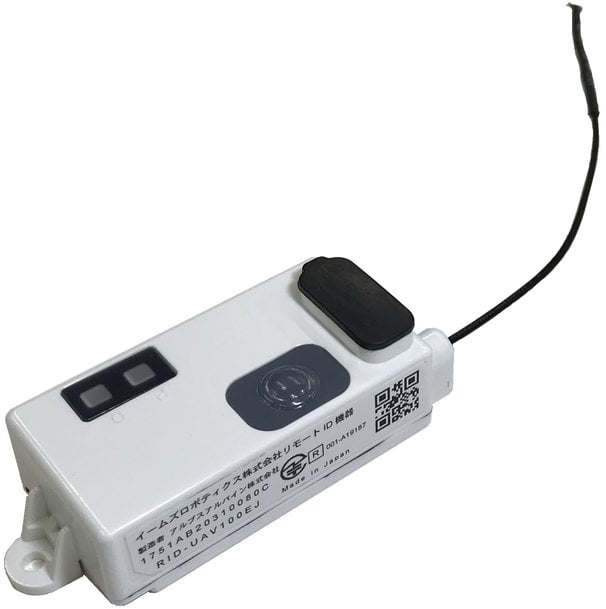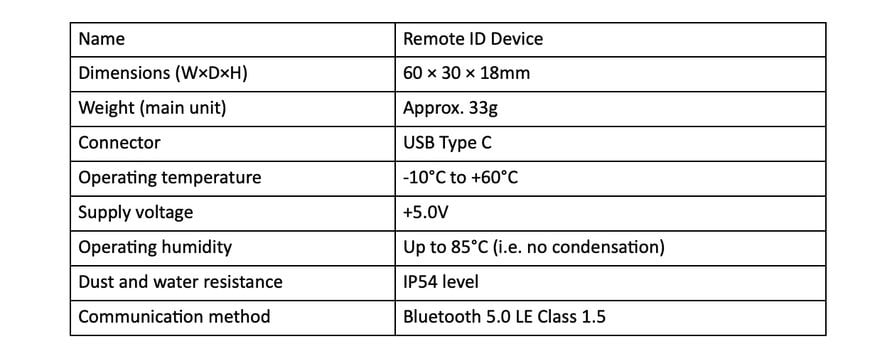www.industry-asia-pacific.com
26
'22
Written on Modified on
Alps Alpine to Start Mass Producing “Remote ID Device” for Drones
Alps Alpine Co., Ltd. ( President & CEO: Toshihiro Kuriyama) has developed the “Remote ID Device,” a radio transmitter for unmanned aircraft (drones). The Remote ID Device transmits drone identification data, including unique identifiers (registration IDs) and location information, and conforms to specifications prescribed by Japan’s Ministry of Land, Infrastructure, Transport and Tourism (MLIT).

Mass production will begin toward the end of May 2022, ahead of other companies and prior to Civil Aeronautics Act amendments taking effect on June 201 that make drone registration and display of registration IDs mandatory. The device is already slated for use by Japanese industrial drone manufacturer EAMS Robotics Co., Ltd. (headquarters: Fukushima Prefecture; President & CEO: Eiji Soya). EAMS Robotics will also be a conduit for sales to other drone manufacturers, having connections to drone industry experts and businesses. Besides drones, Alps Alpine envisages application to other forms of mobility and will continue development with aims, amid a shrinking and aging population, to contribute to a future society where people and robots move around with greater convenience, safety and peace of mind.
Background to the Development
In Japan, a low birth rate and aging of the population are causing the working age population – those aged between 15 and 64 – to contract dramatically. According to the Ministry of Internal Affairs and Communications (MIC)2, Japan’s working age population as of October 1, 2021, was 74,504,000, down 584,000 from the previous year. This came to 59.4% of the total population – the smallest it has ever been. And the trend is expected to accelerate. Contraction of the working age population affects society in a number of ways, the biggest concern beingpotential economic decline due to a shortage of workers. Government and corporations have driven efforts in recent years to grow the number of workers by creating better working environments for women and the elderly, but it is essential that the labor force gets an even bigger boost now in the face of quickening contraction of the available population.
Drones are looked to as a tool to help compensate for the worker shortage. In regions where the above trends are especially pronounced, a compelling case can be made for use of drones in logistics as a short-distance transportation method connecting the last mile between local distribution centers and the point of final delivery. Drones can also be used to safely and efficiently carry out inspections of infrastructure or other equipment or facilities in elevated locations, hilly terrain or other places where work can be dangerous or inefficient, without human labor. However, issues remain, such as the risk of drones colliding in the air and the difficulty of locating a drone for retrieval after a crash.

Amendments to the Civil Aeronautics Act addressing these issues will take effect on June 20, 2022. It will become mandatory for drones with a take-off weight of 100 grams or more to be registered with the MLIT-administered DIPS-REG drone registration system and for registration IDs to be displayed on drones. Unlike a registration plate on an automobile, however, information displayed on a drone cannot be confirmed from the ground while it is in flight. Drones will therefore need to carry remote ID equipment for transmitting registration ID and other data over radio waves.
Outline of the Development
The Remote ID Device developed by Alps Alpine, conforming to MLIT-prescribed specifications, transmits drone identification data, including unique identifiers (registration IDs) and location information, using radio waves. Because the equipment can be affixed to a drone retroactively, drones of customers that are already in use can be made to meet standards set out in the Civil Aeronautics Act.
A drone’s position is pinpointed using a built-in Global Navigation Satellite System (GNSS) function and its registration ID is transmitted using an Alps Alpine-developed module compatible with Bluetooth 5.0 Low Energy Long Range. Communication range in actual use reaches at least 1,500 meters. The ID is retrieved and confirmed using a special-purpose application. Barometric altitude is accommodated with an Alps Alpine-developed atmospheric pressure sensor. Compact size and light weight are realized with the main housing measuring 60 × 30 × 18mm (W×H×D) and weighing 33 grams despite carrying a lithium-ion battery. In addition, know-how acquired in the automotive business is applied to achieve IP54 dust and water resistance for excellent reliability. Functionality can be expanded by connecting an external device to the USB connector. In the future, we will also realize function expansion by updating the software, applying communication technology not limited to registration ID transmission.
Outlook
In anticipation of expanded scenarios for drone usage, Alps Alpine will team up with Japanese industrial drone manufacturer EAMS Robotics and together advance sales targeting industrial drones. We will also explore future application to other forms of mobility that will likely need to support remote location employing unique IDs amid acceleration of an aging society and emergence of a sharing economy. This could include electric carts for the elderly, equipped with an obstacle detection unit3 like one being developed by Alps Alpine, and share bicycles. With an aging population,our aim is to help bring about a society where people and robots in coexistence get to move around with greater convenience, safety and peace of mind.
1. Unmanned Aircraft Registration Web Portal (MLIT)
https://www.mlit.go.jp/koku/drone/en/
2. “Current Population Estimates as of October 1, 2021” announced by MIC on April 15, 2022
https://www.stat.go.jp/english/data/jinsui/2021np/index.html
3. Press release, June 16, 2021: Alps Alpine Obstacle Detection Unit Employed in Fukushin Next-Generation Electric Cart, POLCAR SPX-1
https://www.alpsalpine.com/j/news_release/2021/0616_01.html (in Japanese)
Specifications

www.alpsalpine.com

